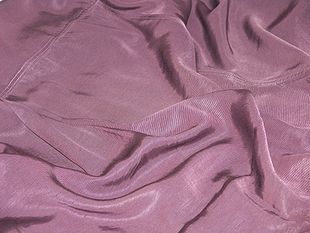Regenerated fiber
Regenerated fibers are fibers that are made from naturally occurring, renewable raw materials using chemical processes. These are mainly cellulose derivatives made from wood. Together with synthetic man-made fibers, they are classed as man-made fibers and are not natural fibers .
Types and characteristics
The most important regenerated fibers are:
- Viscose (CV) is produced using the viscose process from pure cellulose, which is mainly obtained from eucalyptus, beech or pine wood, but increasingly also from bamboo.
- Modal (CMD) is produced according to a modified viscose process, in which only cellulose from beech wood is used, which is why fibers of this type have a higher strength than viscose in both dry and wet conditions.
- Lyocell (CLY) is produced in a wet spinning process from cellulose that has previously been liquefied using N -methylmorpholine- N -oxide monohydrate as a solvent. The fiber is characterized by its very high dry and wet strength.
- Cupro (CUP) is also made from cellulose, only using the copper oxide-ammonia process.
Viscose has a typical fiber fineness of about 10 to 15 μm in diameter and a fiber length of about 40 mm. Viscose is spun into a continuous thread for the textile industry. Fine microfibers are available from 0.9 dtex (0.9 g per 10,000 m of thread length). The newer processes ( Modal , Lyocell ) achieve higher fiber strength, better moisture absorption and faster drying. Produced therefrom textiles have a smooth and cool touch, drape, have a low tendency to wrinkle and can be washed and dry cleaned. However, this requires further process steps in order to suppress the pronounced wet fibrillation behavior.
Manufacturing
In the form of pulp present solid cellulose is first liquefied in suitable solvents, pressed in this state through spinnerets and then regenerated back to solid cellulose (in the form of cellulose fibers). Since cellulose is neither meltable nor soluble in the usual organic solvents, finding the appropriate solvent is of crucial importance. At present, special systems are used for cellulose liquefaction, which often consist of several components, such as the sodium hydroxide / carbon disulfide (NaOH / CS 2 ) system. Gained increasing technical importance has also the direct dissolution method using N -Methylmorpholin- N oxide monohydrate (NMO MH *). The requirements for cellulose for the production of regenerated fibers are i. d. Usually higher than that of cellulose for paper production (higher purity and better reactivity).
Depending on whether the fibers are formed in a precipitation bath or by evaporation of the solvent, the spinning processes are again differentiated into wet spinning processes and dry spinning processes. But there are also mixed forms such as the Lyocell process , which is a dry-wet spinning process.
The same applies to the production of acetate and triacetate fibers, whereby it should be noted here that the end products in this case are not again cellulose fibers, as just described, but are made of cellulose acetate , i.e. a chemically different substance. They do not count among the regenerated fibers.
use
Regenerated fibers are used in functional textiles in the sports sector, for work clothing, underwear and bedding, and as nonwovens for hygiene and cosmetic articles (e.g. wadding). The fiber is also used for textiles in the medical field and for industrial products. In the technical field, regenerated fibers are used as reinforcement fibers for tires and to replace glass fibers in fiber composites .
Economical meaning
Regenerated fibers are an established material in the clothing segment and as nonwovens . In Germany there is an internationally successful and export-strong cellulose fiber industry. Around 200,000 t of regenerated cellulose are produced annually. Although the quality of the local wood is suitable for the production of regenerated fibers, the raw material cellulose is currently fully covered by imports from South Africa and the USA / Canada, as Germany lacks the production capacities for chemical cellulose. In addition to chemical cellulose, regenerated fibers that have already been processed are also imported into Germany in order to meet current demand.
sustainability
Traditional processes like the viscose process are technically very complex and polluting (strong acids and bases, carbon disulfide [CS 2 ] and heavy metals ). Against the background of the excellent properties of the cellulose molecule and its potential as a renewable raw material , great efforts have been made in recent decades to develop environmentally friendly and at the same time technically simpler processes. So was u. a. developed the carbamate process, which uses harmless urea instead of the toxic carbon disulfide , or the lyocell process , which is practically emission-free due to the almost complete recovery of the solvent N -methylmorpholine- N -oxide in the process cycle and has therefore won the European Union's environmental award.
supporting documents
- ↑ H.-P. Fink and S. Fischer: Cellulose processing - environmentally friendly technologies on the advance . Fraunhofer Institute for Applied Polymer Research.
- ^ FNR [specialist agency for renewable raw materials] (2006): Market analysis of renewable raw materials; Gülzow
- ↑ Fraunhofer Institute for Applied Polymer Research: Carbamate ( Memento from June 13, 2007 in the Internet Archive )
literature
- H.-P. Fink and S. Fischer: Cellulose processing - environmentally friendly technologies on the advance . Fraunhofer Institute for Applied Polymer Research.
Web links
- International Association of the Natural Textile Industry: Press release on bamboo viscose (PDF; 44 kB)
